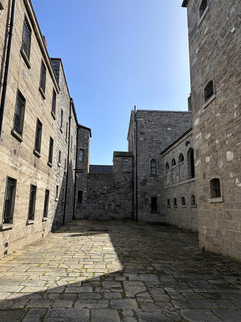Dublin - Much to See, But Don’t Hang Your Lock on the Ha’penny
- debbiemanderson1
- Apr 23, 2024
- 10 min read

If you are like me and fell in love with the charming little city of Belfast, you might be surprised when you reach the big city of Dublin. But as one fellow told us, for better or worse, Dublin had a 30-year head start as Belfast’s development was stunted by ‘The Troubles’.
Dublin sits half-way down the east coast of Ireland, linked by the River Liffey to the Irish Sea and, eventually, the Atlantic Ocean. It’s less than two hours away from Belfast by express bus, and the ride is pleasant, traversing some beautiful green Irish countryside. It indeed has a different vibe than Belfast given the urban population numbers over 1,000,000. With the ‘big city’ atmosphere, Dublin offers some major sights.
Our hotel was situated in the south east corner of the central city, near the Aviva Stadium. This is a lush area with nice brownstone walk-up townhouses and government embassies. Although it was a 20 minute walk into the downtown, the transit was only steps away, and the location afforded us some respite from the ‘busy-ness’ of downtown. (It was interesting to watch the well-managed hoards of people swarming down the street in front of our hotel to the stadium for a rugby match one evening. The stadium sits 50,000 and was sold -out.)

Our Dublin hotel.
Several of Dublin’s major sights are concentrated in the central area, all within walking distance.
The first sight you might see when you enter downtown Dublin is St. Stephen’s green, a majestic park in the city centre. It is described as an historical park with four centuries of history and is a calm space in the bustling centre. There are many statues reflecting Ireland's history, birds, plants, a playground, water features, and flowers. There are many great coffee shops on the streets surrounding the park.
Two of the significant must-sees in the downtown are the main cathedrals, Christ Church and St. Patrick’s, just blocks from each other and now both belonging to the Church of Ireland. They seem to be in competition in their magnificence. With that much age, you might want to research both church’s history. Why were they built so close to each other and did they always co-exist happily? (Hint - there might have been conflict in the early years, but I have read that the main dispute now is which is the ‘best’ tourist experience.)
Christ Church Cathedral is almost 1,000 years old. Over the centuries, it has undergone extensive renovation and enlargement. We attended the choral evensong one Sunday afternoon to experience a service in such a magnificent space. We were surprised at the sparse attendance for such a huge church. (Attending a service is also a good way to get a glimpse of the cathedral without paying the entrance fee.)

Christ Church Cathedral with the poignant ‘Homeless Jesus’ statue in front.

Inside Christ Church Cathedral
St. Patrick’s Cathedral is slightly younger than Christ Church, dating to the early 1200’s and built outside the original city walls, and has also undergone extensive renovations over the centuries. It is apparently Ireland’s largest church. St. Patrick’s sits on a lovely garden where, legend has it, St. Patrick baptized the first Irish Christians.


Whichever you like best, both buildings are grand and imposing.
But one church we truly enjoyed was little St. Audoen’s, Dublin’s oldest medieval church, built between 1181 and 1212, where we were given a free personal tour by a most knowledgeable attendant. It was built within the walls of the medieval city of Dublin, and the interior is humble (in contrast to the huge cathedrals nearby) with many symbolic features. There is an interesting free exhibit in the entry explaining the church’s history.
These are only three of the many churches in Dublin - they seem to be on every corner.
Trinity College is worth a visit in central Dublin. It is Ireland’s oldest university, founded in 1592. It is known for its academic standing and has had some famous students such as Oscar Wilde. There are few public entrances but once you find them, you will see beautiful lawns amongst stately buildings, including the Old Library which houses the Latin biblical manuscript Book of Kells from 800 AD. Tours are available, but we chose just to roam on our own.

The interesting globe statue, Sphere Within Sphere, is outside the library at Trinity College. The meaning of the sculpture has been debated. Some suggest it represents the greed and exploitation of the world. It stands out amidst the traditional stately buildings and is probably a meet-up point.
Dublin’s City Hall and the Dublin Castle are two magnificent adjacent structures in central Dublin. City Hall dates to the late 1700’s and has a beautiful rotunda supported by twelve 32-foot pillars. It looks like this might be a popular location for weddings.


Dublin Castle was built in the 13th century on the highest ground in central Dublin. For years, it was the centre for administration of Ireland but has been a government complex and convention centre since about 1922.
We chose not to tour the castle but enjoyed the somewhat secret garden behind the castle and in front of the Chester Beatty Library. The garden has existed since the early 17th century. Besides commemorative statues within four smaller garden sections, there is an interesting grassy lawn in the centre, the Dubh Linn Garden, where patterns representing sea serpents are cut into the lawn. Some say that the Chester Beatty Library is an amazing spot to see medieval manuscripts and oriental art once owned by, well, Chester Beatty, a self-made philanthropist. And the Chester Beatty Library also contains the Silk Road cafe which looked very inviting. This is another great respite from the crowds.
Most people associate Dublin with the Temple Bar area, so we had to pay a visit. This area has morphed over the years from marshland to wealthy residences to a ‘red-light’ district to, eventually, what it is today - a bohemian, artistic, entertainment, tourist, shopping area. Sure enough, the area is concentrated with pubs and, as expected, the original Temple Bar, itself, dating to 1840, had a line-up. It sits 600, and I imagine that it is often full. But here’s a hint - stop and take a picture of the Temple Bar and then walk just a couple of blocks away to find a lesser-known pub. We arrived at one at 2:00 pm, opening time, and were the only people there for awhile, allowing us to enjoy a late lunch and beverage in a real Irish bar experience. Temple Bar wasn’t our cup of tea (or should I say, not our pint of brew).

There doesn’t seem to be any proof that Molly Malone was a real person, but she is part of Dublin folklore, a fictional ‘fishwife’ who sold, as you know, cockles and mussels on the streets off Dublin and just maybe (but maybe not) was a prostitute by night. Interestingly, new controversy relates to the fact that tourists tend to rub her ample breasts which is seen as an objectification of women. It’s an interesting read. Do stop by if you are in downtown Dublin. It’s a good site for some fun photo ops (especially if you are singing “cockles and mussels, alive, alive-o”)
Aside from the popular St. Stephen’s Green, there are several other parks in the central area to enjoy.
Merrion Square is a large and grand green space surrounded by Georgian Houses which have been the homes of some of Ireland’s rich and famous. It contains the triangular National Memorial to defence forces, as well as colourful flowers and shrubs and statues; and artists hang their art for sale on the park railings.
Herbert Park was close to our hotel. It might be slightly larger than St. Stephen’s Green and popular with locals. This is apparently the best place to see cherry blossoms in the city and, fortunately, they were all showing off when we were there. There was also romance in the air as couples strolled the pathways under the cherry blossoms. Herbert Park was the site of the 1907 Irish Exhibition trade show and still has an original bandstand and a pond.
Iveagh Gardens is another historic park that was once an earl’s garden. It is known as Dublin’s “secret garden” as many people focus more on the larger, more popular St. Stephen’s Green, and it is more difficult to find. This is a National Historic Property. The gardens have a waterfall, a rose garden, and a maze that was patterned after London’s Hampton Court maze.
While we are on the subject of parks, we had fully intended to visit the massive Phoenix Park in the northwestern area of Dublin but were put off by frigid wind and rain that turned to hail at one point that day. Phoenix Park is one of the largest enclosed parks in any European city. It has gardens, a zoo, miles of trails, a deer herd, playing fields, and cafes. There appear to be many parks to discover outside the city centre. Dublin is also traversed by several canals that make for super walking and cycling opportunities. The Grand Canal walk in Dublin is part of a 117 kilometre trail, of which we walked a very short distance.
Along the Grand Canal.
Aside from the parks, we found downtown Dublin to be somewhat crowded and ‘touristy’, so we were happy to take the train heading out of the downtown for a tour of the old Kilmainham Gaol towards the western side of Dublin. If you know me, I can’t miss a good jail tour. Kilmainham Gaol was opened in 1796 as a county jail. It held common and political prisoners, including women. We had a super tour guide who was animated in his presentation and informed us, not only of the history of the jail, but also of Ireland’s political history which had such a bearing on which prisoners were sent there. The jail has a little cafe with tasty food and coffee. Be sure to book your tickets early (28 days in advance, right when they become available) as they sell out fast.

Ireland is known for it’s whiskey, and there are numerous distilleries to visit. We did not tour any, but our walks took us by the large Jameson Distillery, founded in 1780, north of the river in the up and coming area of Smithfield. If you are a whiskey-lover, this might be your place. You can take your pick of at least nine such facilities to tour in Dublin, depending on your taste.
There are several bridges allowing easy access to the north of the river. A fun, traditional bridge to cross is the old Ha’penny (officially the Liffey) walking bridge dating to 1816. It might be iconic, but it is also utilitarian as it is heavily travelled which resulted in a re-do in the early 2000’s. Interestingly, about 300 kilograms of ‘lovelocks’ were removed, and citizens have been asked not to place any more such locks on the bridge, due to the weight, I presume. (They will have to take their love elsewhere.)

In contrast to the Ha’penny, the much younger Samuel Beckett Bridge to the east stands out for it’s design and, sure enough, it won the Engineers Ireland ‘Engineering Project of the Year” Award in 2010. It was opened in 2009 and is said to resemble a harp lying on its side.

The Samuel Beckett Bridge takes you directly to the north side of the docklands area. The docklands have been under development since 1997 and is much more modern than the downtown, full of glassed-in office buildings with history woven in.
There are several statues of note in the docklands area, the most heartfelt being the Famine statue on Custom House Quay north of the river. The statue consists of six figures and a dog commemorating more than one million Irish who lost their lives to starvation during the Great Famine in the 19th century brought about by the potato blight. The famine also resulted in a huge Irish emigration. As many Irish were trying to reach Canada, there is a commemorative plaque from the government of Canada at the statue. This is a solemn, haunting, and emotional place, and it is worth some quiet reflection. Canada has a similar statue but of only five figures (the lesser number representing the lives lost in the emigration) at Ireland Place in Toronto.

The Jeanie Johnston replica ship lies in the harbour close to the Famine Statue. Tours are available, telling the story of some 2,500 emigrants from Ireland to Canada or New York in the original Jeanie Johnston during the famine from 1848 to 1855. The original ship was built in Canada.

Then we encountered possibly the best museum we have ever attended, “EPIC - The Irish Emigration Museum”. EPIC is not an acronym, although staff have joked that it could stand for “Every Person Is Connected” - it is a reflection of the ‘epic’ journeys and contributions that Irish emigrants have made in the world. The museum opened in 2016 and is built in the underground vaults of a former docklands warehouse at the Custom House Quay. It is interactive and, for the most part, technological. Not surprisingly, the creators of the Titanic Museum in Belfast also had a hand in this museum. Covering the history of emigration from Ireland, including political and economical and prejudicial factors, the museum looks at how Irish emigrants (or persons with Irish heritage) have contributed to all different aspects of society in the world from technology to science to sports to arts to food to activism. This museum is suited for everyone. You are given a passport at the beginning to have stamped in each section, 20 rooms in total. This is one splendid museum. No wonder it is listed as one of the most popular tourist museums in Europe. My photos do not do it justice.
There are numerous museums in Dublin that we did not visit but would be worthy if you are interested, everything from the National Museum of Ireland to the National Leprechaun Museum.
O’Connell Street is an important historical street in Dublin, running north from the Liffey River. It contains several statues of prominent figures in Irish history and was the site of conflicts including the assault on the General Post Office. At one time a grand street, O’Connell Street became run down and home to many fast food restaurants; so, in 2003 in an attempt to rejuvenate the street, the Spire of Dublin or the ‘Spike’ was built, standing 120 metres high and reflecting the Irish skies. With good Irish humour, the Spire has many nicknames, some derogatory: The Nail In The Pail, The Pin In The Bin, The Spire In The Mire . . . . You might want to check on your own for more colourful nicknames (apparently the Dubliners have many different views of this work of art). It’s an interesting stroll to walk down the centre of the street, admire the statues (old and the new), maybe look out for bullet holes that are a reminder of history, and visit the The Garden of Remembrance at the north end of the street.

The Garden of Remembrance has a centre sunken water feature (The Tranquil Pool) with embedded tiles that symbolize the old tradition of throwing battle weapons into the river to signify the end of hostilities. The focal statue (The Children of Lir) represents children being transformed into swans before becoming human again. It’s a real place for calm and quiet reflection.
As would be expected, there are some traditional residential streets in the O’Connell Street area. We enjoyed watching an historical documentary being made. A lot of work goes into one small clip.

And that concludes our four days in Dublin, Ireland. I hope this blog has given you a glimpse of this Irish capital. It certainly does not have the charm of Belfast, but once you accept that it is a big city with big city vibes, you will discover some big sights (just don’t hang your love lock on the Ha’penny).
Our next stop is Cork in Southern Ireland.
Enjoy the photo collage:




























































































































































































































Comments